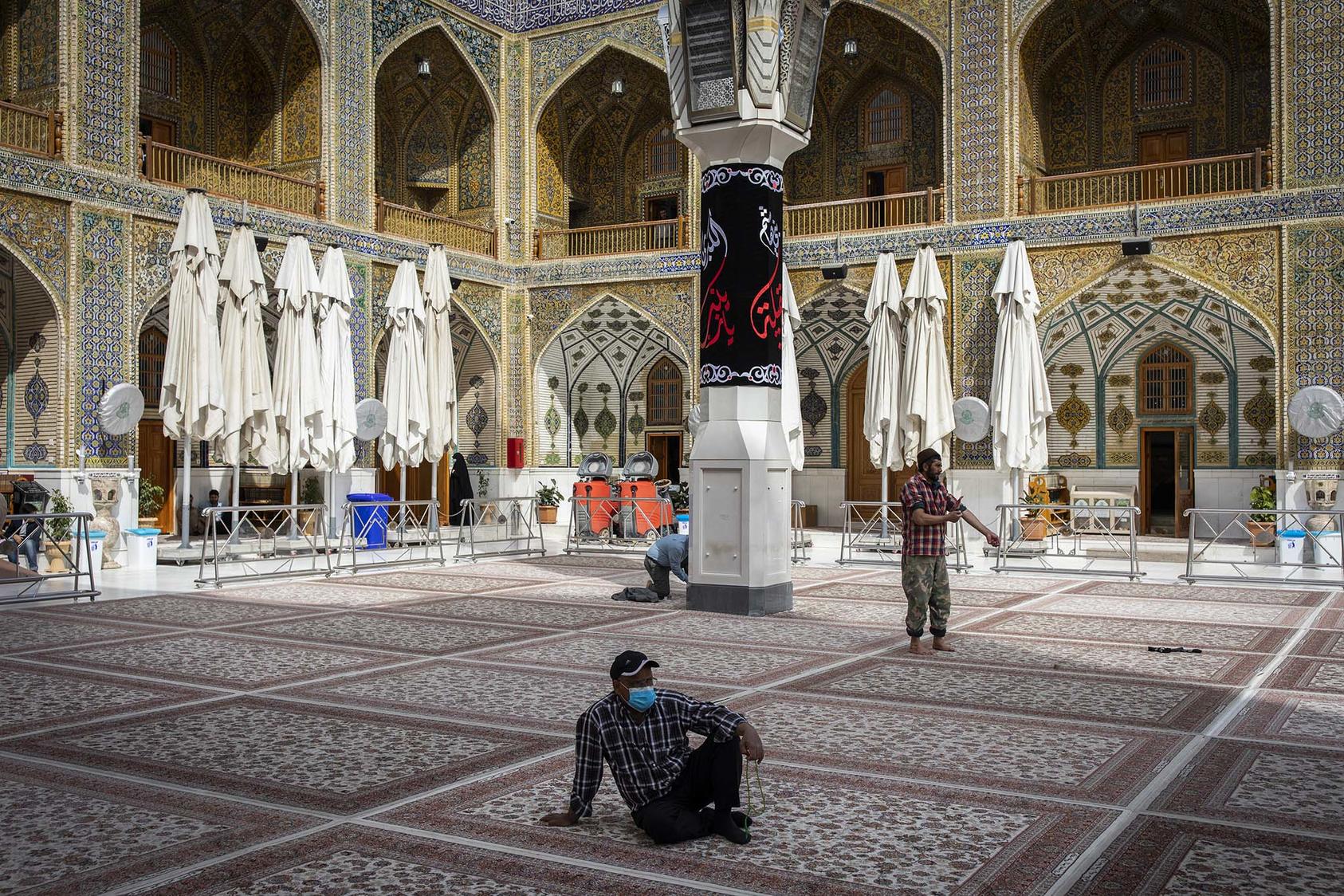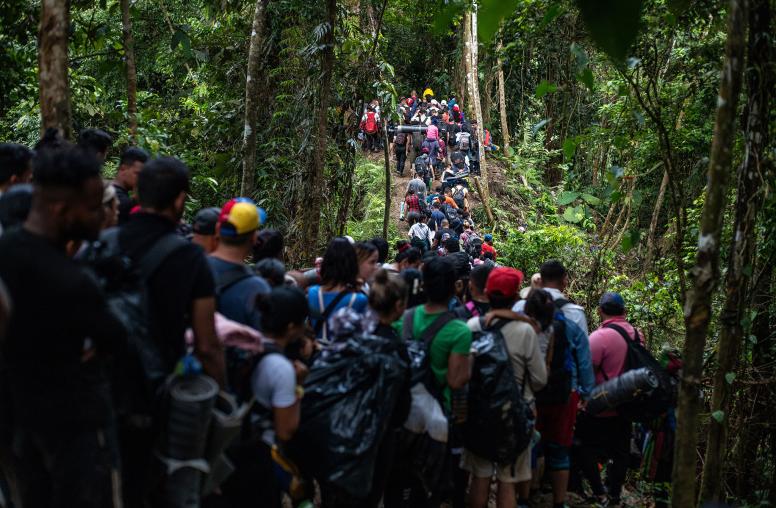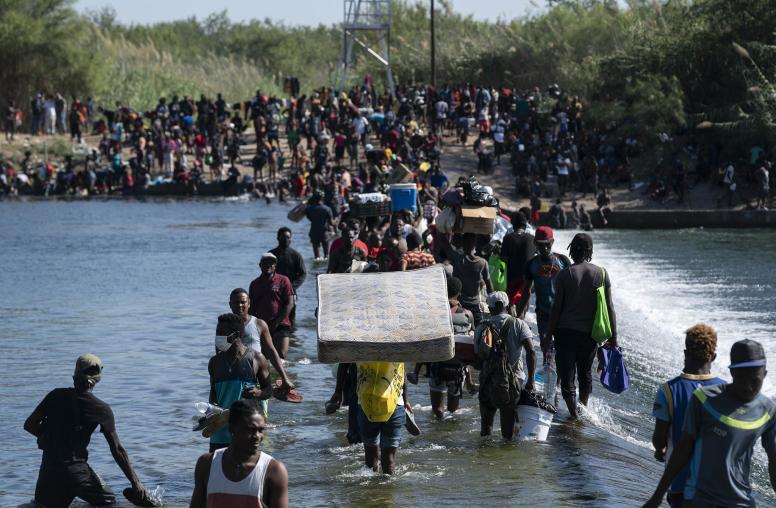Six Challenges Facing a Fragile Middle East Amid Coronavirus
Now, more than ever, solidarity and cooperation are needed to mitigate the impact of a COVID-19 outbreak in the region.
The COVID-19 pandemic has proven a challenge even for wealthy countries with the most robust health care systems. For the Middle East—a region with no shortage of dangerous pre-existing conditions—it could be far worse. The virus now appears to be spreading to a part of the world where, over the past decade, conflict and displacement have become widespread while effective governance and social cohesion have eroded.

From packed refugee camps in Jordan to the ungoverned spaces of Libya to the still-unspooling civil war in Syria, the Middle East appears particularly vulnerable not only to infection by the pandemic—but also to seeing its shock exacerbate long-standing fractures and obstacles to collective problem-solving.
The challenge for the Middle East today continues to be one of leadership and political will. The question is whether the crisis set off by COVID-19 can catalyze political and economic efforts to resolve protracted conflicts.
The spread of the virus in the region comes atop several of the world’s most acute humanitarian crises, most notably in Syria, Yemen, Gaza, and Afghanistan. It will be confronted in these conflict zones by weak health care systems and infrastructure that can’t cope with existing situations.
In immediate response to the pandemic, almost all of the region’s governments have taken unprecedented steps to close schools and universities; prohibit public gatherings, including prayers; impose quarantines and curfews; and raise public awareness of how to curb the spread of the virus. Most borders and airports in the region are temporarily closed.
These are sensible emergency responses. In addressing the pandemic in the medium and longer range, the nations of the Middle East ideally must improve testing and health care capacity across classes; ensure the availability of accurate and timely information; enhance coordination and cooperation between states; seek immediate stabilization in conflict settings; strengthen the role of local players, particularly in conflict zones, while ensuring complementary, meaningful international support; and seek means of addressing the economic repercussions of this crisis.
COVID-19 in a Fragile Middle East
Unfortunately, the worst is almost certainly yet to come. Social distancing is not easily accomplished in the Middle East’s overcrowded cities and refugee camps, and border control is by no means universal.
In the past few days, Gaza counted 10 infections and Syria and Libya reported one each. As this is written, Yemen has not yet reported any. It is likely, however, that COVID-19 is already spreading in all of these conflict zones but escaping much detection due to lack of testing.
The pandemic exacerbates the challenges of aid efforts, which are difficult in conflict zones in the best of times. Now, humanitarian workers face disruptions in global supply chains, shipping interruptions, travel restrictions, and delays in decision-making. At the same time, as aid agencies prepare for the imminent arrival of the virus, they have to maintain their ongoing operations as well.
Priority should be given to minimizing loss of life everywhere, particularly in already stressed conflict environments. The Middle East’s millions of displaced persons—often living in tightly packed camps with poor sanitation and health services—represent a prime example of the risks at play in the region and their potential scale. In Gaza, two million Palestinians live in one of the most densely populated places on earth, with little infrastructure and few services. There are 6.7 million Syrian refugees, mainly in Turkey, Lebanon, and Jordan, and 6.2 million internally displaced people in Syria—constituting about half the population.
Challenges Ahead
Six primary challenges face decision-makers in this environment:
1. Impactful internationalism: It remains to be seen whether broad-scale and effective bilateral and multilateral cooperation can be achieved, including through major international organizations. The long-standing debate over globalization will only deepen in the current environment. Skeptics see the virus as supporting a turn to sealed borders, limited trade, reduced immigration, and advancing an inward-looking agenda. Globalization advocates contend that only multilateral cooperation can successfully manage such global crises, and that failures to control the pandemic stem from a lack of an international approach. They argue, correctly, for a more effective multilateral system to build and advance an equitable and comprehensive public health response to this crisis. There is an important role here for the U.N., the G20, and other regional and international bodies.
In times of crisis, one can expect states to be preoccupied primarily with their own societies. Nevertheless, cooperation should be much more extensive. Two examples are worth highlighting, one in which expected cooperation failed to materialize, and a second where unanticipated cooperation was achieved.
- Italian-EU Cooperation: Early this year, Italy presented its needs to confront COVID-19 to the EU. At the time, no other member states were seriously affected by the virus and none responded. Initially, EU member states displayed limited solidarity. EU institutions fared better. Aid was late in reaching Italy. Had the EU countries responded swiftly, they might have helped in containing the outbreak more effectively and thereby limited their own exposure.
- Israeli-Palestinian Cooperation: Unexpected cooperation has emerged from the region’s most institutionalized conflict. While it’s a truism that a virus knows no borders, Israeli and Palestinian authorities are viewing the maxim as an urgent truth. With the exception of security coordination, cooperation between Israelis and Palestinians has eroded steadily since the last round of negotiations that failed in 2014. In response to COVID-19, however, both governments—from the health ministries to security services—have worked together in ways both sides privately acknowledged as constructive and advanced. The rapid response underscores the degree to which both understand their societies are intertwined and affect each other in countless ways. Hopefully, the Israeli-Palestinian spring to action will prove more than an anomaly.
In these crises, a lesson repeatedly learned, but too often forgotten, is the necessity for preparedness and coordination—not only between national health systems, but between states sharing borders, health risks, and more.
2. Providing accurate, timely information and confronting misinformation: There is an abundance of hoax ideas in the Middle East about cures for the virus, wrong information on how it’s transmitted, and falsehoods that belittle the impact of the virus or describe it as a conspiracy. In states with large refugee populations, information problems are intensified. A top priority must be ensuring access to factual and up-to-date information that’s comprehensible and actionable by the target populations.
3. Building resilience: Due to lack of resources and capabilities, many countries hosting large refugee populations are often unable to include refugee populations in preparedness plans for mitigating disasters or epidemics. These countries must get bilateral and multilateral assistance that will enable them to provide for refugees in their national response plans. Further, capacity in the longer term also has to be strengthened in prevention, detection, and response, as well as in maintaining critical medical services and supply networks, to ensure resilience during crises—man-made, natural, or otherwise. Thus far, global prevention and capacity-building efforts have fallen short.
4. Promoting respect for international humanitarian law and humanitarian principles: International humanitarian law increasingly faces major challenges around the world. Grave violations in recent years that have gone unaddressed, including the massive killing of civilians in Syria, give perpetrators a sense of impunity at a time when countries must come together and hold violators accountable. Those seeking protection should not be turned away under the guise of fighting the virus. Key global actors must work to ensure that refugees have access to a quality of health care comparable to citizens.
5. Seeking immediate stabilization: Without increased regional stability, managing the COVID-19 crisis on any level will be difficult, if not impossible. While broad-scale conflict resolution is highly unlikely in the near term, the pandemic may incentivize immediate-term stabilization. Early this month, nine countries and the EU called for a humanitarian cessation of hostilities in order to address COVID-19. The call was welcomed by the two main conflicting parties in Libya, as well as by the U.N. This hopeful development, as well as the call by the U.N. secretary general for a global cease-fire, followed by similar calls for Syria and Yemen, should be followed by active and forceful efforts to stabilize these crises.
6. Addressing economic repercussions: Many Middle East countries are particularly vulnerable to COVID’s fast-rising economic costs. Declining demand for oil has already had a huge impact on the Gulf countries. Tourism-dependent nations including Egypt, Tunisia, and Morocco have seen significant declines in traffic. Economies that rely on workers’ remittances from the Gulf will also suffer. More importantly, the global recession will have a major impact on trade, investment, the travel industry, and the ability of resource-rich countries to provide assistance to those in the region most in need of humanitarian assistance.
The possibility of exacerbation of conflicts, political unrest, and violence should not be excluded, particularly when the economic repercussions of pandemic start to be felt. The spread of the virus makes many challenges in the Middle East all the more daunting. Solidarity and cooperation, regionally and internationally, will be facing one of its biggest challenges in recent history. The need has never been greater for necessity to be the mother of invention.

